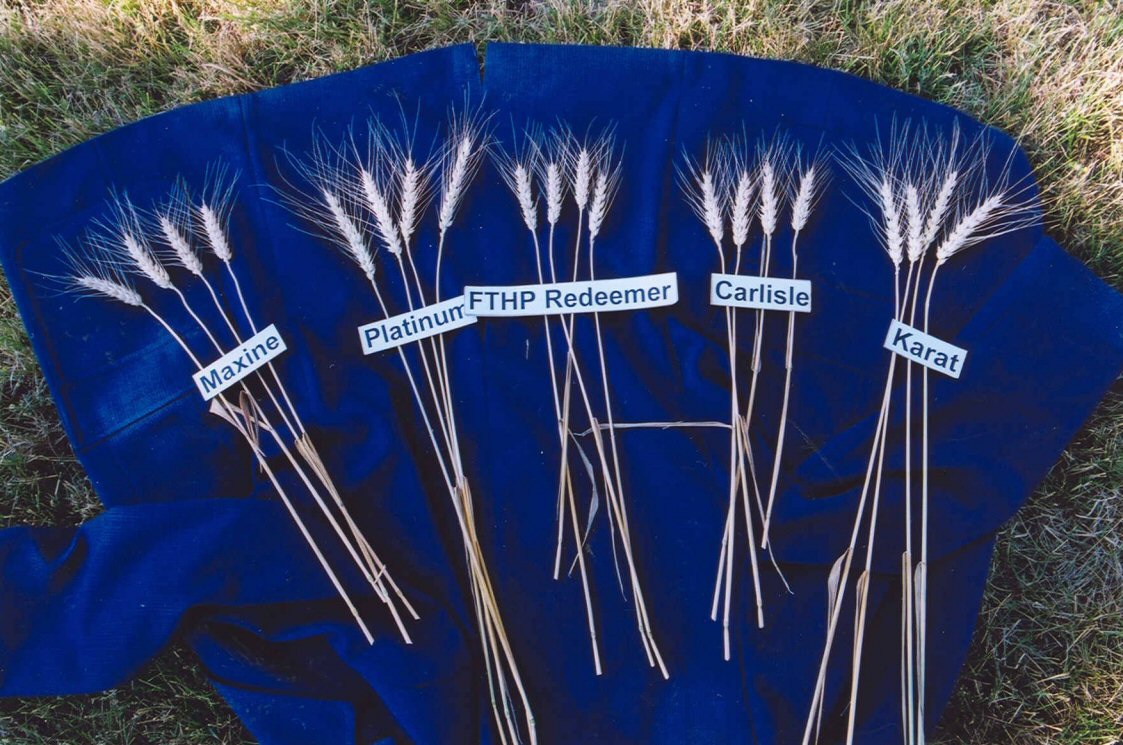FTHP Redeemer
| Denomination: | 'FTHP Redeemer' |
|---|---|
| Previously Proposed Denomination: | 'Redeemer' |
| Botanical Name: | Triticum aestivum |
| Applicant/Holder: |
University of Guelph Research Innovation Office Building #92, 50 Stone Road East Guelph, Ontario N1G 2W1 Canada |
| Breeder: |
Institute of Field and Vegetable Crops, Novi Sad, Serbia and Montenegro |
| Application Date: | 2006-03-28 |
| Application Number: | 06-5393 |
| Grant of Rights Date: | 2008-05-26 |
| Certificate Number: | 3214 |
| Date rights surrendered: | 2010-06-02 |
Variety Description
Varieties used for comparison: 'Maxine', 'Platinum', 'Carlisle' and 'Karat'
Summary: 'FTHP Redeemer' has green coleoptiles at emergence while they are purple for 'Platinum'. 'FTHP Redeemer' matures earlier than 'Platinum' and 'Karat'. The sheaths and blades of the lower leaves of 'FTHP Redeemer' have stonger pubescence than the reference varieties. The flag leaf of 'FTHP Redeemer' is shorter than 'Platinum' and 'Karat' and more narrow than all of the reference varieties. 'FTHP Redeemer' has weaker glaucosity on the lower side of the flag leaf than 'Karat'. The flag leaf auricles of 'FTHP Redeemer' have weaker anthocyanin colouration than 'Platinum' and 'Karat'. Glaucosity of the flag leaf sheath and culm neck is weak and very weak, respectively, for 'FTHP Redeemer' while it is medium for 'Maxine' and 'Karat' and strong for 'Carlisle'. The culm neck is relatively straight for 'FTHP Redeemer' while it is quite curved for 'Maxine'. Glaucosity of the spike is very weak for 'FTHP Redeemer' while it is medium for 'Carlisle' and medium to strong for 'Karat'. The lower glumes of 'FTHP Redeemer' have a slightly sloping to elevated shoulder while those of 'Platinum' and 'Carlisle' are straight. 'FTHP Redeemer' has the smallest in both glume length and width and beak length compared to the reference varieties. 'FTHP Redeemer' has a better bread quality and a higher protein percentage than the reference varieties.
Description:
YOUNG PLANT (4 leaf stage): absent or very weak anthocyanin colouration of coleoptiles, pubescent sheaths and lower leaf blades
PLANT: winter type, semi-erect growth habit, early maturity, low tendency to recurved flag leaves
STEM AT MATURITY: yellow, thin walled in cross-section, no anthocyanin colouration
CULM NECK: very weak glaucosity, straight with very weak curvature, white anther
FLAG LEAF: medium to dark green, glabrous on upper side, no glaucosity on lower side, intermediate between upright and drooping attitude
FLAG LEAF SHEATH: glabrous, weak glaucosity
FLAG LEAF AURICLES: absent or very weak anthocyanin colouration, weak pubescence of margins
SPIKE: parallel sided, medium density, incline attitude at maturity, very weak glaucosity, white at maturity, medium to dense hairiness of margin of apical rachis segment
AWNS: medium length at tip of spike, mostly spreading attitude, white
LOWER GLUME: narrow to medium width, short to medium length, glabrous, slightly sloping to elevated shoulder, medium width shoulder, slightly curved beak, short beak, sparse extent of internal hairs
LEMMA: straight beak
KERNEL: hard red type, dark red to amber, medium to large, midlong to long, midwide to wide, elliptical, angular cheeks, midlong to long brush hairs, midwide to wide crease, mid-deep to deep crease
GERM: medium to large, round
QUALITY CHARACTERISTICS: good resistance to shattering and winter survival, good bread quality, high protein content
RESISTANCE TO DISEASE: moderate susceptibility to Septoria Tritici Blotch (Septoria tritici); moderate resistance to Leaf Rust (Puccinia triticina)
Origin & Breeding History: 'FTHP Redeemer' (experimental designation KV12401) originated from the cross Lira/2*Kosovka made by the breeder Dr. Srbislav Dencic and Borislav Kobiljski at the Institute of Field and Vegetable Crops, Small Grains Department in Novi Sad, Serbia, in 1995. Individual plants were selected in the F2, F3 and F4 generations based on their winter hardiness, yield, resistance to disease (Fusarium Head Blight, Powdery Mildew and Leaf Rust) and bread making quality. From 2002 to 2004, 'FTHP Redeemer' was tested at twelve different locations across Ontario and evaluated for yield, disease resistance and bread making characteristics. It appeared to have exceptional tolerance to Fusarium Head Blight and has exceptionally high protein content. 'FTHP Redeemer' was supported for registration by the Ontario Cereal Crop Variety Committee in January 2005. Breeder seed was first bulked in 2004 in the F9 generation. One line was bulked to form this variety.
Tests & Trials: The tests and trials for 'FTHP Redeemer' were conducted during the summers of 2005 and 2006 in Ridgetown, Ontario. Plots consisted of 6 rows, 4 metres in length at 15 cm row spacing with 40 cm between plots. There were 4 replicates arranged in a Random Complete Block Design.
Comparison tables for 'FTHP Redeemer' with reference varieties 'Maxine', 'Platinum', 'Carlisle' and 'Karat'
Flag leaf length (cm)
| 'FTHP Redeemer' | 'Maxine' | 'Platinum' | 'Carlisle' | 'Karat' | |
|---|---|---|---|---|---|
| mean | 17.6 | 15.1 | 22.4 | 16.4 | 22.6 |
| std. deviation | 2.1 | 1.5 | 2.3 | 1.9 | 2.8 |
Flag leaf width (mm)
| 'FTHP Redeemer' | 'Maxine' | 'Platinum' | 'Carlisle' | 'Karat' | |
|---|---|---|---|---|---|
| mean | 12.6 | 14.6 | 13.3 | 15.8 | 15.4 |
| std. deviation | 1.1 | 0.8 | 1.2 | 0.8 | 1.4 |
Spike length (excluding awns) (cm)
| 'FTHP Redeemer' | 'Maxine' | 'Platinum' | 'Carlisle' | 'Karat' | |
|---|---|---|---|---|---|
| mean | 7.4 | 6.8 | 9.0 | 7.0 | 8.2 |
| std. deviation | 0.3 | 0.4 | 0.8 | 0.3 | 0.4 |
Kernel weight (grams per 1000 kernels)
| 'FTHP Redeemer' | 'Maxine' | 'Platinum' | 'Carlisle' | 'Karat' | |
|---|---|---|---|---|---|
| mean | 41.6 | 39.9 | 34.8 | 44.1 | 41.3 |
Click on image for larger view

Wheat: 'FTHP Redeemer' (centre) with reference varieties 'Maxine' (left), 'Platinum' (centre left), 'Carlisle' (centre right) and 'Karat' (right)
Click on image for larger view

Wheat: 'FTHP Redeemer' (centre) with reference varieties 'Maxine' (left), 'Platinum' (centre left), 'Carlisle' (centre right) and 'Karat' (right)
- Date modified: